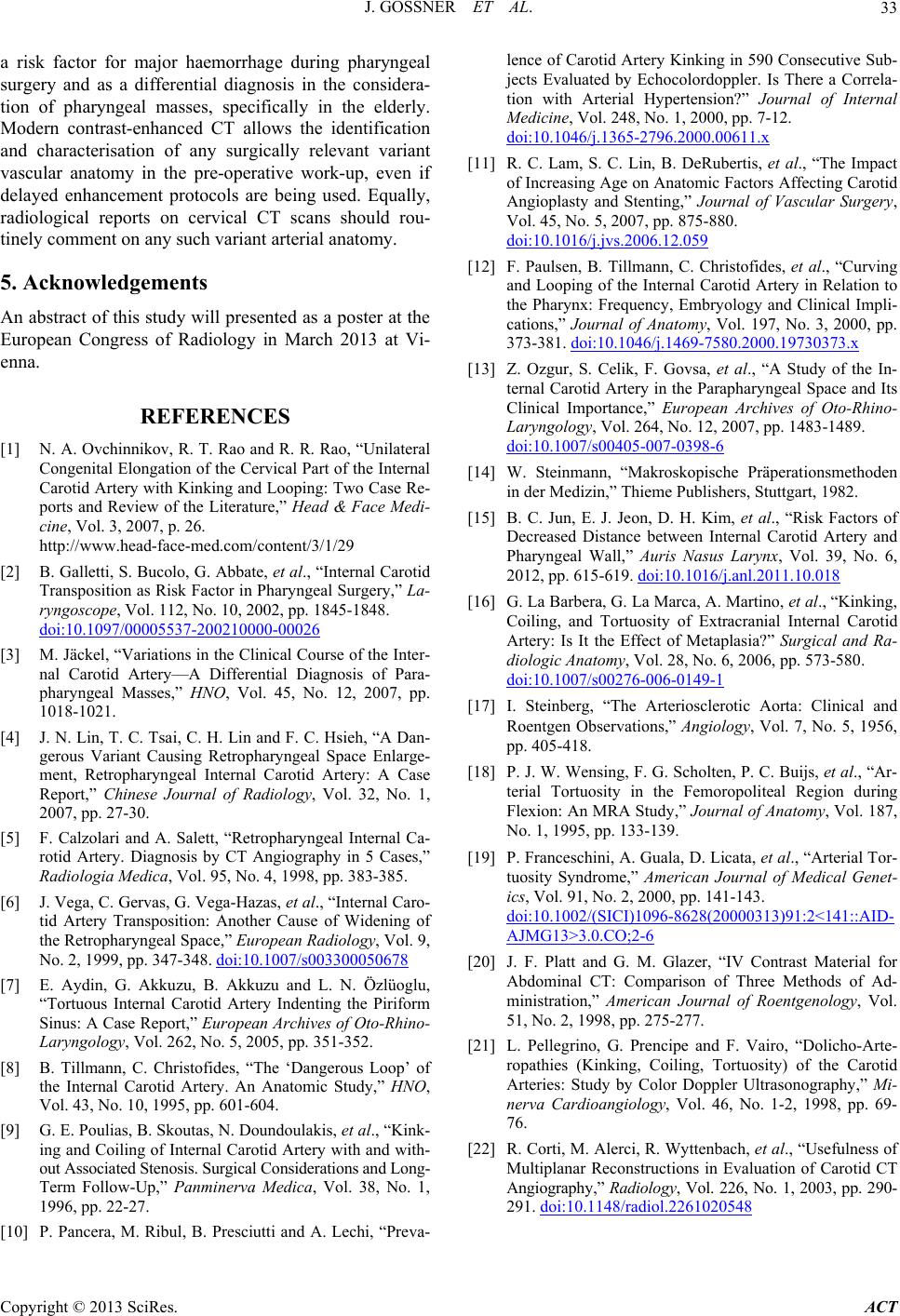
J. GOSSNER ET AL.
Copyright © 2013 SciRes. ACT
33
a risk factor for major haemorrhage during pharyngeal
surgery and as a differential diagnosis in the considera-
tion of pharyngeal masses, specifically in the elderly.
Modern contrast-enhanced CT allows the identification
and characterisation of any surgically relevant variant
vascular anatomy in the pre-operative work-up, even if
delayed enhancement protocols are being used. Equally,
radiological reports on cervical CT scans should rou-
tinely comment on any such variant arterial anatomy.
5. Acknowledgements
An abstract of this study will presented as a poster at the
European Congress of Radiology in March 2013 at Vi-
enna.
REFERENCES
[1] N. A. Ovchinnikov, R. T. Rao and R. R. Rao, “Unilateral
Congenital Elongation of the Cervical Part of the Internal
Carotid Artery with Kinking and Looping: Two Case Re-
ports and Review of the Literature,” Head & Face Medi-
cine, Vol. 3, 2007, p. 26.
http://www.head-face-med.com/content/3/1/29
[2] B. Galletti, S. Bucolo, G. Abbate, et al., “Internal Carotid
Transposition as Risk Factor in Pharyngeal Surgery,” La-
ryngoscope, Vol. 112, No. 10, 2002, pp. 1845-1848.
doi:10.1097/00005537-200210000-00026
[3] M. Jäckel, “Variations in the Clinical Course of the Inter-
nal Carotid Artery—A Differential Diagnosis of Para-
pharyngeal Masses,” HNO, Vol. 45, No. 12, 2007, pp.
1018-1021.
[4] J. N. Lin, T. C. Tsai, C. H. Lin and F. C. Hsieh, “A Dan-
gerous Variant Causing Retropharyngeal Space Enlarge-
ment, Retropharyngeal Internal Carotid Artery: A Case
Report,” Chinese Journal of Radiology, Vol. 32, No. 1,
2007, pp. 27-30.
[5] F. Calzolari and A. Salett, “Retropharyngeal Internal Ca-
rotid Artery. Diagnosis by CT Angiography in 5 Cases,”
Radiologia Medica, Vol. 95, No. 4, 1998, pp. 383-385.
[6] J. Vega, C. Gervas, G. Vega-Hazas, et al., “Internal Caro-
tid Artery Transposition: Another Cause of Widening of
the Retropharyngeal Space,” European Radiology, Vol. 9,
No. 2, 1999, pp. 347-348. doi:10.1007/s003300050678
[7] E. Aydin, G. Akkuzu, B. Akkuzu and L. N. Özlüoglu,
“Tortuous Internal Carotid Artery Indenting the Piriform
Sinus: A Case Report,” European Archives of Oto-Rhino-
Laryngology, Vol. 262, No. 5, 2005, pp. 351-352.
[8] B. Tillmann, C. Christofides, “The ‘Dangerous Loop’ of
the Internal Carotid Artery. An Anatomic Study,” HNO,
Vol. 43, No. 10, 1995, pp. 601-604.
[9] G. E. Poulias, B. Skoutas, N. Doundoulakis, et al., “Kink-
ing and Coiling of Internal Carotid Artery with and with-
out Associated Stenosis. Surgical Considerations and Long-
Term Follow-Up,” Panminerva Medica, Vol. 38, No. 1,
1996, pp. 22-27.
[10] P. Pancera, M. Ribul, B. Presciutti and A. Lechi, “Preva-
lence of Carotid Artery Kinking in 590 Consecutive Sub-
jects Evaluated by Echocolordoppler. Is There a Correla-
tion with Arterial Hypertension?” Journal of Internal
Medicine, Vol. 248, No. 1, 2000, pp. 7-12.
doi:10.1046/j.1365-2796.2000.00611.x
[11] R. C. Lam, S. C. Lin, B. DeRubertis, et al., “The Impact
of Increasing Age on Anatomic Factors Affecting Carotid
Angioplasty and Stenting,” Journal of Vascular Surgery,
Vol. 45, No. 5, 2007, pp. 875-880.
doi:10.1016/j.jvs.2006.12.059
[12] F. Paulsen, B. Tillmann, C. Christofides, et al., “Curving
and Looping of the Internal Carotid Artery in Relation to
the Pharynx: Frequency, Embryology and Clinical Impli-
cations,” Journal of Anatomy, Vol. 197, No. 3, 2000, pp.
373-381. doi:10.1046/j.1469-7580.2000.19730373.x
[13] Z. Ozgur, S. Celik, F. Govsa, et al., “A Study of the In-
ternal Carotid Artery in the Parapharyngeal Space and Its
Clinical Importance,” European Archives of Oto-Rhino-
Laryngology, Vol. 264, No. 12, 2007, pp. 1483-1489.
doi:10.1007/s00405-007-0398-6
[14] W. Steinmann, “Makroskopische Präperationsmethoden
in der Medizin,” Thieme Publishers, Stuttgart, 1982.
[15] B. C. Jun, E. J. Jeon, D. H. Kim, et al., “Risk Factors of
Decreased Distance between Internal Carotid Artery and
Pharyngeal Wall,” Auris Nasus Larynx, Vol. 39, No. 6,
2012, pp. 615-619. doi:10.1016/j.anl.2011.10.018
[16] G. La Barbera, G. La Marca, A. Martino, et al., “Kinking,
Coiling, and Tortuosity of Extracranial Internal Carotid
Artery: Is It the Effect of Metaplasia?” Surgical and Ra-
diologic Anatomy, Vol. 28, No. 6, 2006, pp. 573-580.
doi:10.1007/s00276-006-0149-1
[17] I. Steinberg, “The Arteriosclerotic Aorta: Clinical and
Roentgen Observations,” Angiology, Vol. 7, No. 5, 1956,
pp. 405-418.
[18] P. J. W. Wensing, F. G. Scholten, P. C. Buijs, et al., “Ar-
terial Tortuosity in the Femoropoliteal Region during
Flexion: An MRA Study,” Journal of Anatomy, Vol. 187,
No. 1, 1995, pp. 133-139.
[19] P. Franceschini, A. Guala, D. Licata, et al., “Arterial Tor-
tuosity Syndrome,” American Journal of Medical Genet-
ics, Vol. 91, No. 2, 2000, pp. 141-143.
doi:10.1002/(SICI)1096-8628(20000313)91:2<141::AID-
AJMG13>3.0.CO;2-6
[20] J. F. Platt and G. M. Glazer, “IV Contrast Material for
Abdominal CT: Comparison of Three Methods of Ad-
ministration,” American Journal of Roentgenology, Vol.
51, No. 2, 1998, pp. 275-277.
[21] L. Pellegrino, G. Prencipe and F. Vairo, “Dolicho-Arte-
ropathies (Kinking, Coiling, Tortuosity) of the Carotid
Arteries: Study by Color Doppler Ultrasonography,” Mi-
nerva Cardioangiology, Vol. 46, No. 1-2, 1998, pp. 69-
76.
[22] R. Corti, M. Alerci, R. Wyttenbach, et al., “Usefulness of
Multiplanar Reconstructions in Evaluation of Carotid CT
Angiography,” Radiology, Vol. 226, No. 1, 2003, pp. 290-
291. doi:10.1148/radiol.2261020548